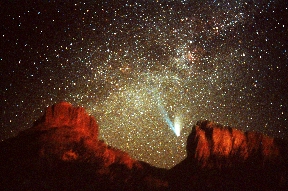| |
 
|
 |
 |
 |
 |
 Comets
are not only among the most spectacular events in
the sky, but they are also unique, in that they
are known to be the best preserved raw materials
in our Solar System. Comets are cold bodies, commonly
known as "icy travelers". We see them
only because the gases in their coma and tails fluoresce
in sunlight and because of the sunlight reflected
from the solids. Comets
are not only among the most spectacular events in
the sky, but they are also unique, in that they
are known to be the best preserved raw materials
in our Solar System. Comets are cold bodies, commonly
known as "icy travelers". We see them
only because the gases in their coma and tails fluoresce
in sunlight and because of the sunlight reflected
from the solids.
Comets are regular members of our Solar System family,
gravitationally bound to the Sun, generally, comets
are believed to be made of materials that originated
in the outer parts of the Solar System, but that
did not get incorporated into its leftover "debris".
Comets are thought to be composed of such unchanged
primitive materials, they are extremely interesting
to scientists who wish to learn more about the conditions
during the earliest period of the Solar System.
Comets are very small in size relative to planets.
Their average diameter is about 5-10 kilometers;
however, they are irregular in shape, with longest
dimension often twice the shortest. The best evidence
suggests that comets are fragile. If you had a large
piece of cometary material, you could simply pull
it in two with your bare hands, as if it were a
poorly compacted snowball.
Comets are believed to have brought water and an
abundant variety of carbon-based molecules to earth
in its late phase of evolution. Scientists also
believe that comets have contributed an essential,
if not leading, part to the start of life here on
Earth. It is only through complex investigations
that we hope to learn more about the nature of these
cometary molecules and the role of comets in more
detail. |
| Last updated December
29, 2003 |
|
|
|
|
